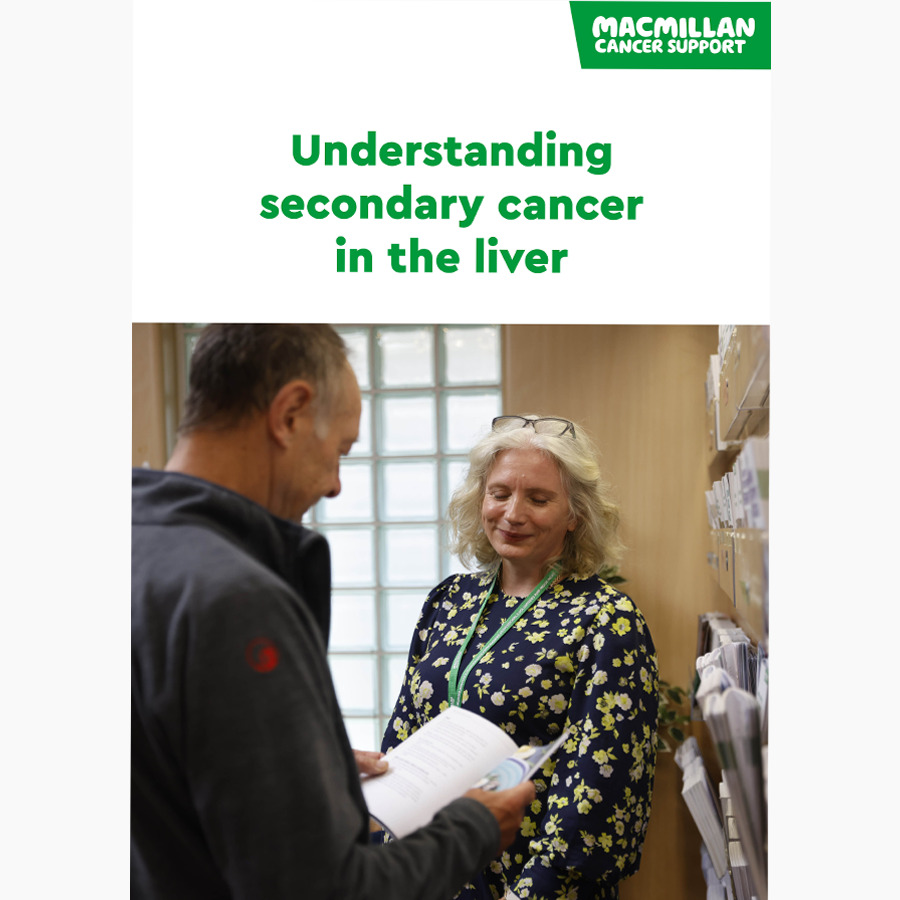Secondary liver cancer
Choose a type
What is secondary liver cancer?
Secondary cancer in the liver is when cancer cells spread to the liver from a primary cancer in another part of the body. It is also called secondary liver cancer.
The place where a cancer starts in the body is called the primary site. Sometimes cells break away from the primary cancer. These cancer cells are carried in the bloodstream or lymphatic system to another part of the body. They may stay in that part of the body and make a new tumour. If this happens, it is called a secondary cancer or metastasis.
Cancer cells entering the bloodstream
Any type of cancer can spread to the liver But some types are more likely to than others. These include:
- bowel cancer
- breast cancer
- cancer of the pancreas
- stomach cancer
- oesophageal cancer
- lung cancer
- melanoma
- neuroendocrine tumours (NETs) – tumours that start in neuroendocrine cells in organs such as the stomach, bowel and lungs.
If you have secondary liver cancer, it is best to read this information along with our information for the primary cancer you have.
Sometimes cancer can start in the liver. This is called primary liver cancer, which is rare. Secondary liver cancer is much more common.
Related pages
Booklets and resources
Symptoms of secondary cancer
Secondary liver cancer may not cause any symptoms for a long time. In some people be found during routine tests. Some possible symptoms include:
Possible symptoms may include:
- loss of appetite and feeling full soon after starting to eat
- weight loss
- feeling sick (nausea) and being sick (vomiting)
- tiredness (fatigue)
- the skin and whites of the eyes looking yellow (jaundice).
These symptoms can be caused by other conditions. But it is important to get them checked by your doctor or nurse.
We have more information about the symptoms of secondary liver cancer.
Related pages
Causes of secondary liver cancer
The cause of secondary liver cancer depends on the primary cancer that has spread to the liver.
Diagnosis of secondary liver cancer
If you have symptoms, you will usually begin by seeing your GP, who will examine you. They may arrange some tests or refer you directly to see a specialist doctor at the hospital.
Sometimes secondary liver cancer is diagnosed at the same time as the primary cancer.
It may also be diagnosed following regular scans or blood tests as part of follow up after treatment for a primary cancer, such as bowel cancer.
If secondary liver cancer is found before the primary cancer is diagnosed, your doctor usually arranges tests to find out where the primary cancer is. In some people the primary cancer cannot be found. This is called a cancer of unknown primary.
The tests you have will depend on your individual situation. Tests may include:
-
Blood tests
You will have blood tests to check your general health and how well certain organs are working.
-
Liver blood tests
Liver blood tests check how well your liver is working. They measure the following:
- The level of a waste product called bilirubin in the blood – too much might mean the liver is not working as well as it should be.
- The level of a protein called albumin in the blood – a low level could mean the liver is not working as well as it should be.
- How quickly your blood clots – slower clotting might mean a problem with liver function.
If your liver blood tests show signs of possible liver damage, your doctor may arrange further tests to find out what is causing it.
-
Tumour markers
Some cancers produce proteins called tumour markers. These can also be measured in the blood. The level of a tumour marker may be higher than normal in people with certain cancers. Your cancer doctor may use different tumour markers to help diagnose and monitor the cancer. They can also show whether the cancer is responding to treatment
-
CT scan
A CT scan makes a detailed picture of the inside of the body. The picture is built up using x-rays taken by the CT scanner.
-
Liver ultrasound scan
An ultrasound scan uses sound waves to build up a picture of the liver. The doctors use it to find out the size and location of any tumours. It also shows them how healthy the liver is.
-
MRI scan
An MRI scan uses magnetism to build up a detailed picture of areas of the body.
-
Liver biopsy
You may have a small piece of tissue taken from the liver to be looked at under a microscope. This is called a liver biopsy.
Diagnosing the primary cancer
Occasionally, secondary cancer is found in the liver before the primary cancer is diagnosed.
If this happens, your doctor may arrange for you to have tests to find out where the primary cancer is. They can tell you more about these tests and what they involve.
Waiting for test results can be a difficult time. We have more information that can help.
Treatment for secondary liver cancer
A team of specialists will meet to discuss the best possible treatment for you. This is called a multidisciplinary team (MDT).
Your doctor or cancer specialist or nurse will explain the different treatments and their side effects. They will also talk to you about things to consider when making treatment decisions. You will need this information before you give your permission (consent) to have any treatment.
Treatment for secondary liver cancer aims to control the cancer for as long as possible and reduce any symptoms. The treatment you have depends on:
- where the cancer started (what the primary cancer is)
- the parts of the liver that are affected
- whether there is cancer in other parts of the body.
You might have anti-cancer drug treatments that can treat the cancer wherever it is in the body. There are also treatments that directly treat the tumour in the liver.
-
Chemotherapy
Chemotherapy uses anti-cancer drugs to destroy cancer cells. It is the most common treatment for secondary liver cancer. Doctors may use it:
- to try to control the cancer
- to relieve symptoms
- before liver surgery, to try to shrink the cancer
- after liver surgery, to reduce the risk of the cancer coming back in that area.
-
Targeted therapies
Targeted therapy are drugs that find and attack cancer cells. There are many different types of targeted therapy. Each one targets something in or around the cancer cell that is helping it grow and survive.
Before doctors can give you some types of targeted therapy drugs, they need to test the cancer cells. This is to find out whether the drug is likely to work for you.
-
Immunotherapy
Immunotherapy drugs stimulate the immune system to fight cancer cells. They are usually given on their own. They may be used to treat different cancers, for example, cancer that started:
-
Hormonal therapies
Hormonal therapies work by changing how certain hormones are produced or behave in the body. They are often used to treat cancer that started in the breast or prostate. There are different types of hormonal therapy. The type used depends on the type of cancer. You usually have hormonal therapy as tablets or injections.
The following treatments directly treat the tumour in the liver:
-
Surgery
Sometimes it is possible to remove the affected part or parts of the liver with surgery. This is called a liver resection. It is most often done to remove bowel cancers or neuroendocrine tumours that have spread to the liver. Very rarely doctors might consider doing a liver transplant. This type of operation is highly complex and rarely possible.
We have more information about surgery for secondary cancer in the liver.
-
Ablation
Tumour ablation means destroying the tumour by applying heat, alcohol or electrical pulses directly to it. Types of ablation are:
- microwave ablation (MWA)
- radiofrequency ablation (RFA)percutaneous ethanol injection (PEI)
- irreversible electroporation (IRE).
We have more information about ablation for liver tumours.
-
Embolisation treatments
Embolisation is a way of cutting off the blood supply to the tumour in the liver. Some people have embolisation on its own. This is called trans-arterial embolisation or TAE. Or you may have it with:
- chemotherapy – this is called chemoembolisation or trans-arterial chemoembolisation (TACE)
- radiotherapy – this is called radioembolisation or selective internal radiotherapy (SIRT).
We have more information about embolisation treatments for liver cancer.
-
Radiotherapy
Sometimes doctors use a type of radiotherapy that closely targets tumours in the liver. This is called stereotactic ablative radiotherapy (SABR) is sometimes used to treat secondary liver cancer.
Radiotherapy uses high-energy rays (radiation) to destroy cancer cells. It can also be used to ease symptoms such as pain. This is called palliative radiotherapy. You might have this if the cancer has spread to another part of the body, such as the bones.
-
Controlling symptoms
Doctors and nurses also use supportive treatments to help control symptoms and improve quality of life. Your cancer doctor may refer you to doctors and nurses who specialise in controlling symptoms of secondary liver cancer.
We also have more information about coping with advanced cancer.
You may have some treatments as part of a clinical trial. We have more information about treating secondary liver cancer.
After secondary liver cancer treatment
Follow-up after treatment for secondary liver cancer
You will have regular check-ups during and after your treatment. Your doctor or nurse will monitor your health and treat any symptoms caused by the cancer. You may have scans or blood tests to check the cancer or the effects of any treatment.
Tell your doctor or specialist nurse as soon as possible if you have any problems or notice new symptoms between appointments.
We have more information about follow-up care after treatment.
Support after secondary liver cancer
People often have many different feelings when they finish cancer treatment. You may feel relieved that treatment has finished, but worried about what will happen in the future.
Macmillan is also here to support you. If you would like to talk, you can:
- Call the Macmillan Support Line for free on 0808 808 0000.
- Chat to our specialists online
- Visit our secondary liver cancer forum to talk with people who have been affected by secondary liver cancer, share your experience, and ask your questions.
Well-being and recovery
It can take time to recover after cancer treatment. Some days you may feel better than others.
After treatment you are likely to feel very tired. You may also still be coping with some side effects. It is important to take care of yourself and allow your body time to recover. Ask family or friends to help. This can save you energy for the things you want to do.
Eating well and taking some gentle physical activity may also help you feel better.
We have more information about wellbeing after cancer treatment.
About our information
This information has been written, revised and edited by Macmillan Cancer Support’s Cancer Information Development team. It has been reviewed by expert medical and health professionals and people living with cancer.
-
References
Below is a sample of the sources used in our secondary liver cancer information. If you would like more information about the sources we use, please contact us at informationproductionteam@macmillan.org.uk
Cervantes A, Adam R, Rosello S, et al; Metastatic colorectal cancer: ESMO Clinical Practice Guideline for diagnosis, treatment and follow-up. Ann Oncol. 2023 Jan;34(1):10-32. doi: https://doi.org/10.1016/j.annonc.2022.10.003. Epub 2022 Oct 25. [accessed March 2023]
National Institute for Health and Care Excellence (NICE). Metastatic malignant disease of unknown primary origin in adults: diagnosis and management. Clinical guideline [CG104]. Updated 26 April 2023. Available from: www.nice.org.uk/guidance/cg104 [accessed April 2023].
Stewart CL, Warner S, Ito K, Raoof M, Wu GX, Kessler J, et al. Cytoreduction for colorectal metastases: liver, lung, peritoneum, lymph nodes, bone, brain. When does it palliate, prolong survival, and potentially cure? Current Problems in Surgery. 2018;55(9): 330-379. Available from: www.doi.org/10.1067/j.cpsurg.2018.08.004 [accessed March 2023].
Date reviewed

Our cancer information meets the PIF TICK quality mark.
This means it is easy to use, up-to-date and based on the latest evidence. Learn more about how we produce our information.
The language we use
We want everyone affected by cancer to feel our information is written for them.
We want our information to be as clear as possible. To do this, we try to:
- use plain English
- explain medical words
- use short sentences
- use illustrations to explain text
- structure the information clearly
- make sure important points are clear.
We use gender-inclusive language and talk to our readers as ‘you’ so that everyone feels included. Where clinically necessary we use the terms ‘men’ and ‘women’ or ‘male’ and ‘female’. For example, we do so when talking about parts of the body or mentioning statistics or research about who is affected.
You can read more about how we produce our information here.





